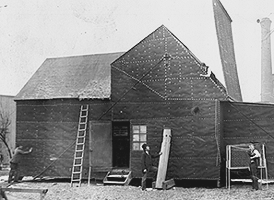
The Black Maria, Edison's first motion picture studio.
History of Edison Motion Pictures:
Early Edison Motion Picture Production (1892-1895)
Early Edison Motion Picture Production (1892-1895) (TOP)

The Black Maria, Edison's first motion picture studio. |
A constant flow of new film subjects was needed to keep the new invention popular, so a motion picture production studio was built at West Orange in December 1892. It was dubbed the Black Maria on account of its resemblance to a police patrol wagon. The studio had a roof that could be opened to admit sunlight for illumination, and the building itself was mounted on a revolving pivot so that the structure could be constantly repositioned to keep it aligned with the sun.
(The Black Maria's era came to an end in January 1901 when Edison inaugurated a new glass-enclosed studio on a rooftop in New York.)
The first motion pictures made in the Black Maria were deposited for copyright by W. K. L. Dickson at the Library of Congress in August 1893. The earliest copyrighted film that still survives is Edison Kinetoscopic Record of a Sneeze, January 7, 1894, also known as Fred Ott's Sneeze, which records Fred Ott, an Edison employee, sneezing comically for the camera. This motion picture was not submitted to the Copyright Office on celluloid film, but rather as a series of positive photographic prints.
A series of vaudeville performers became some of the first subjects to appear before the Kinetograph at the Black Maria. These included such well-known acts as the strongman Eugene Sandow, the Spanish dancer Carmencita, and Annabelle Whitford performing her famous Butterfly Dance. Acts from Buffalo Bill's Wild West Show were filmed, including Annie Oakley and a troop of Native American dancers who performed in the show. Many of the films were expected to appeal to male audiences, and some even featured scantily-clad women. Other masculine activities, such as boxing and cockfights, were also filmed. Dickson and Heise filmed over 75 motion pictures during 1894.
On April 1, 1894, the manufacture and sale of Kinetoscopes and films were assigned to the Edison Manufacturing Company, thus moving them out of the experimental laboratory. The Kinetograph Department, a new division in the Edison Company, was launched.
 Frames from the fourth experimental film made by W.K.L. Dickson for Edison, featuring Dickson tipping his hat. |
The first Kinetoscope parlor, owned by the Holland Brothers, opened on April 14, 1894, in New York. Five machines were placed in a row, and a customer could view the films in each for a total of 25 cents. Kinetoscope parlors soon opened around the United States.
As he had done with the phonograph, Edison marketed his Kinetoscope and films through independently-financed entrepreneurs who formed the Kinetoscope Company. These included Alfred O. Tate, Thomas Lombard, Erastus Benson, Norman C. Raff, Frank R. Gammon, and Andrew Holland. Raff and Gammon in due course became the principal agents of the Kinetoscope Company.
Sales of Kinetoscopes slowed as projected motion pictures began to overtake the peep show machines in 1895. Competitors also emerged who sold their own machines for less, which cut into Edison's profits. Partly to compensate for this and partly to counter the declining popularity of the Kinetograph, the Kinetophone was introduced in April 1895. It represented Edison's dream to unite the motion picture with the phonograph and make talking pictures a reality. To operate the new invention, a patron looked through the peep-hole viewer of a Kinetoscope while listening to a soundtrack piped through ear tubes attached to a Phonograph in the cabinet. The device did not offer exact synchronization and ultimately failed to find a market. The film known today as Dickson Experimental Sound Film is one of the few examples still existing of this early foray into sound.